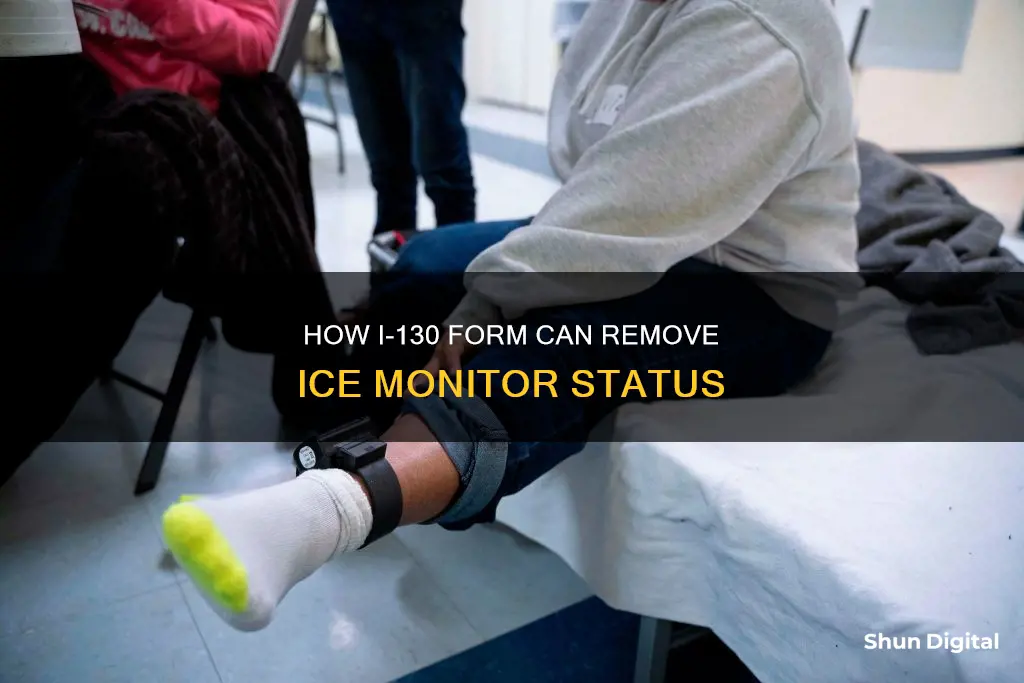
The I-130 form is a petition for an alien relative and can be filed by a US citizen on behalf of their spouse. The form must be accompanied by proof of the bona fides of the marriage, and the marriage must be out of love and not solely for immigration benefits. The I-130 petition does not automatically prevent deportation or removal proceedings, but if approved, an immigration judge may elect to terminate removal proceedings.
ICE's Alternatives to Detention (ATD) programs are designed to ensure compliance with release conditions and provide case management services for non-detained noncitizens. The Intensive Supervision Appearance Program (ISAP) is one such ATD program that utilizes electronic monitoring, including ankle bracelets, in-person check-ins, and home visits. While ATD programs are cheaper than detention, they have been criticized for not effectively preventing aliens from absconding and for not ensuring removal from the US.
The following explores the potential impact of filing an I-130 petition on removal of the ICE ATD monitor.
What You'll Learn

I-130 petition filed while in deportation proceedings
When a person is placed in deportation proceedings, they will receive a Notice to Appear (NTA) before an Immigration Judge. The NTA outlines the reasons for their deportation proceedings. Depending on the allegations, it may be possible to provide a defense against deportation. One such defense is a bona fide marriage to a US citizen, where the citizen has filed Form I-130, Petition for Alien Relative, on behalf of their spouse.
If the marriage occurred while the spouse was in removal proceedings, it is presumed that the marriage was entered into solely to provide an immigration benefit to the immigrant. Therefore, when filing Form I-130, the petitioner must submit proof of the bona fides of the marriage. This includes evidence of joint ownership of property, tenancy of a common residence, combined financial resources, birth certificates of children born to both parties, and affidavits sworn by third parties affirming the authenticity of the marriage.
Once Form I-130 is filed, the petitioner and beneficiary may be scheduled for an interview at a local United States Citizenship and Immigration Service (USCIS) to determine whether the marriage is authentic. If the I-130 is approved, the Immigration Judge may elect to terminate removal proceedings so that the adjustment of status case falls within the jurisdiction of the USCIS. Alternatively, the judge may require that the adjustment of status remains within the jurisdiction of the Immigration Court.
It is important to note that the approval of Form I-130 does not automatically prevent deportation or provide legal status. If the I-130 is approved, the individual will still need to apply for adjustment of status or consular processing, depending on their case. It is recommended to coordinate with both immigration court proceedings and the USCIS to ensure the proper timing and filing of additional forms, such as Form I-485, Application to Register Permanent Residence or Adjust Status.
Destroying LCD Monitors: A Step-by-Step Guide
You may want to see also

Bona fide marriage as a defence
A bona fide marriage is one that is real and genuine, where both spouses are in love and intend to stay together forever. This is in contrast to a fraudulent marriage or sham marriage, which is entered into for the purpose of circumventing immigration laws. To obtain a green card for a spouse, one must file Form I-130, Petition for Alien Relative, with the U.S. Citizenship and Immigration Services (USCIS). This form establishes a qualifying relationship with a foreign spouse and is the first step in obtaining a green card.
Proving a Bona Fide Marriage
USCIS scrutinizes petitions to prevent fraudulent marriages intended solely for immigration benefits. To prove a bona fide marriage, one must provide more evidence than just a marriage certificate. This evidence includes:
- Joint ownership or lease of property
- Joint financial assets and liabilities
- Proof of raising children together
- Proof of relationship and shared activities
- Affidavits from friends and family
- Photos and correspondence
I-130 Petition
The I-130 petition is a critical milestone for couples navigating the U.S. immigration system. It is more than a legal formality; it involves an intimate scrutiny of the authenticity of a relationship. The petitioner must be a U.S. citizen or a green card holder, and the marriage must be legal and valid under the laws of the country where it occurred. Aside from the completed I-130 form, petitioners need to provide proof of their citizenship or permanent resident status, evidence of a valid marriage, and documents proving the termination of any previous marriages.
Defence Against Removal from the U.S.
It is possible to use a marriage to a U.S. citizen as a defence against deportation from the U.S. However, this is not easy and requires the help of a lawyer. If the non-citizen has been placed into removal proceedings, there is a presumption that the marriage occurred solely to gain an immigration benefit. Thus, one must work harder to provide convincing evidence of a bona fide marriage. This evidence must be submitted to USCIS using Form I-130, and a response must be received before the next hearing before an immigration court judge.
If the non-citizen entered the U.S. illegally, they cannot adjust their status in immigration court proceedings and must instead leave the country and apply for consular processing. This will likely result in a ten-year inadmissibility bar on returning to the U.S. The best option in this case is to apply for a provisional waiver, which requires showing extreme hardship to family members.
Asus VS247H-P Monitor: Built-in Speakers or Not?
You may want to see also

Intensive Supervision Appearance Program (ISAP)
The Intensive Supervision Appearance Program (ISAP) is an alternative to detention for immigrants who have been released from detention but are still in deportation proceedings. The program is designed for immigrants who are not considered a threat to public safety or national security but are at a higher risk of committing criminal acts or failing to appear at future immigration hearings.
ISAP allows immigrants to live with their families and continue working while their deportation proceedings are pending. Since deportation proceedings can be lengthy, often lasting years, ISAP provides a good alternative to detention for immigrants with families and community ties in the US.
ISAP participants are closely monitored using a variety of methods, including but not limited to:
- Ankle bracelets with GPS tracking
- Telephonic reporting (using voice recognition software)
- In-person check-ins and home visits
- Smartphone apps with facial recognition
ISAP is operated by BI Incorporated (BI), a subsidiary of The GEO Group, Inc., a large private prison company specializing in operating private, for-profit immigration detention centers. Case specialists are assigned to participants and provide intensive case management services.
The cost of the program is covered by the government, and participants do not have to pay for any ISAP services or technology.
To be eligible for ISAP, non-citizens must be 18 years of age or older, effectively removable from the US, released from DHS custody, and in some stage of the immigration process. The level of supervision and technology assigned to participants is determined by ATD deportation officers based on various criteria, including immigration status, criminal history, public safety concerns, compliance history, community or family ties, medical conditions, and humanitarian factors.
ISAP check-ins are meetings between the participant and their assigned agent to determine compliance with the agreed-upon terms of release. These check-ins are typically scheduled once a month at the closest ICE/ISAP office. Participants are required to attend these check-ins and may face arrest for violating their terms of release if they fail to do so.
There is no formal process for immigration ankle bracelet removal. The decision to remove an ankle bracelet is made by ISAP on a case-by-case basis, and consistent compliance with the terms of release increases the likelihood of removal.
Connecting a PlayStation 4 to a Monitor: A Step-by-Step Guide
You may want to see also

Alternatives to Detention (ATD)
Immigration and Customs Enforcement (ICE) states that immigration detention serves two purposes: protecting the community from noncitizens who may pose a safety risk, and ensuring compliance with immigration proceedings, including removal. Over the last two decades, there has been a growing interest in creating and expanding alternatives to detention for noncitizens. This is due to an increasing understanding that detention is harmful and inhumane, and that there are more humane and cost-effective alternatives.
ATDs can refer to a range of programs with varying levels of government intervention and restrictions on liberties. Generally, alternatives to detention in the immigration context fall into the following categories:
- Release on your own recognizance (no detention and no conditions on release)
- Release on conditions
- Release on bail/bond or other surety
- Community-based supervised release or case management
- Designated residence at a specific accommodation centre
- Electronic tagging and/or tracking
The United States has largely adopted a "detention first" policy, often detaining people first and then providing mechanisms for release. In 2004, ICE piloted an early alternative to detention program, introducing the Intensive Supervision Appearance Program (ISAP). This program has since expanded to over 320,000 people enrolled in 2022, up from 200 in 2004. ISAP uses electronic monitoring, such as ankle monitors, in-person check-ins, and home visits, to track participants' locations.
ICE's ATD programs include ISAP, Extended Case Management Services (ECMS), and in-person check-ins. These programs emphasize monitoring and surveillance, coordination with ICE, and consequences for non-compliance. However, critics argue that these programs have not served as true alternatives to detention, as they have not significantly decreased detention numbers. Instead, they have expanded government control over migrants and immigrant communities.
Community-based alternatives to detention, operated by organizations closely tied to the community and its resources, are considered best practices internationally. These programs provide a range of wraparound services, including housing, employment, language instruction, and legal representation, to support noncitizens through the immigration legal system.
Asus Monitor Warranty: A Lifetime Promise?
You may want to see also

ICE's role in immigration detention
Immigration and Customs Enforcement (ICE) is a US agency that enforces the country's immigration and customs laws. It was created in 2003 under the Department of Homeland Security.
ICE's primary role is to use investigative techniques to apprehend and detain those suspected of violating immigration laws. The Office of Enforcement and Removal Operations (ERO), housed within ICE, carries out the immigration enforcement process, including the identification, arrest, detention, and removal of noncitizens who are subject to removal or are unlawfully present in the US.
ICE manages the nation's civil immigration detention system and oversees a highly transient and diverse population. It is responsible for determining custody for noncitizens, either by detaining them or releasing them with conditions. Detention facilities used by ICE can be owned and operated by ICE, a state or local entity, or a contractor, but they must comply with specific detention standards that ensure the safety and security of staff and detainees.
Detention is non-punitive, and ICE uses its limited detention resources to detain noncitizens for immigration proceedings or removal from the country. This includes those subject to mandatory detention, as well as those deemed a public safety or flight risk. When a noncitizen is not subject to mandatory detention and does not pose a risk, ICE may release them with conditions. This determination is made on a case-by-case basis, considering factors such as the risk of flight, national security threats, and public safety.
ICE also takes into account humanitarian factors, such as serious medical conditions or being the primary caregiver of minor children. In addition, ICE offers Alternatives to Detention (ATD) programs, which allow noncitizens to remain in their communities while complying with release conditions and moving through immigration proceedings. These programs include case management services and technologies like telephonic reporting, GPS monitoring, and smartphone applications.
ICE has been criticized for its management of detention centers, with concerns raised about human rights abuses, inadequate medical care, and the high costs of sustaining its detention infrastructure. There have also been reports of abuse, punitive disciplinary actions, and violations of international human rights laws.
In response to criticism, ICE has implemented reforms, such as hiring medical professionals to review complaints and establishing an independent Office of Detention Oversight. However, the debate around ICE's role in immigration detention continues, with ongoing discussions about the need for further improvements and alternatives to detention.
Oxygen Saturation Monitor: Should You Buy One?
You may want to see also
Frequently asked questions
Filing Form I-130 is just the beginning of a long and difficult process and does not automatically prevent deportation. If the marriage is bona fide and the marriage was not entered into solely to provide an immigration benefit, the Immigration Judge may elect to terminate removal proceedings.
ATD stands for Alternatives to Detention. These are programs that ensure people are not detained for reasons relating to their migration status.
The ATD program uses three types of technology to ensure compliance with release conditions: telephonic reporting, GPS monitoring (ankle bracelets), and the SmartLINK application.







